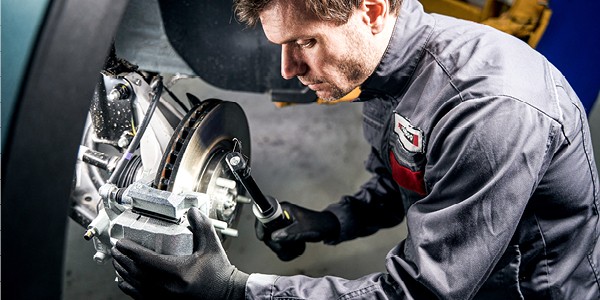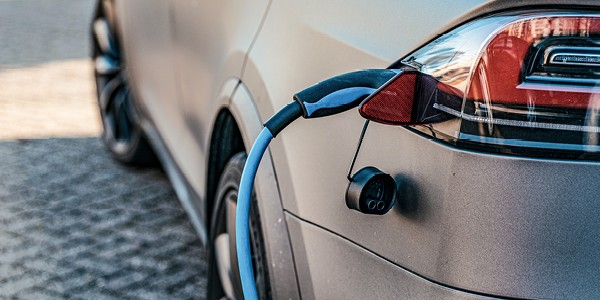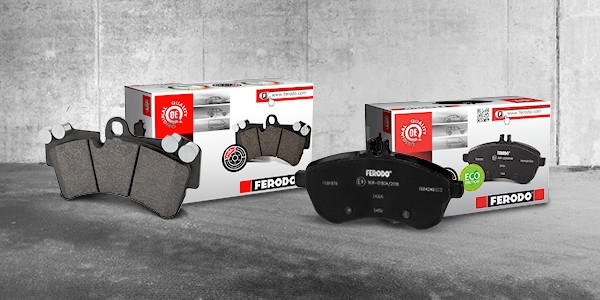 HOW TO PERFORM SAFE, EFFECTIVE BRAKE SERVICE ON EHV’S
HOW TO PERFORM SAFE, EFFECTIVE BRAKE SERVICE ON EHV’S

The rapid electrification of the European passenger car fleet has, understandably, led many workshop owners, mechanics and consumers to wonder how battery-electric and hybrid vehicles will change maintenance and repair processes.
Not surprisingly, most of this attention is focused on vehicle powertrain technologies and the shift from internal combustion engines (ICE) to lithium-ion battery packs. But there are profound changes in other vehicle systems, including brakes, where comparatively heavier electric and hybrid vehicles (EHV) pose new demands that bring new opportunities for well-trained aftermarket professionals.
And make no mistake, the changes represented in EHV brake systems require specialized training and equipment beyond the reach of do-it-yourselfers. Performing a brake repair on a battery-electric or hybrid vehicle is a job for professionals only!
 THE FUTURE HAS ARRIVED
THE FUTURE HAS ARRIVED
If there were any doubts EHV technology would take hold in Europe, they began to disappear in 2021, when electric-car registrations jumped nearly 63%* – to 1,7 million units – over the prior year. In fact, the growth of EHVs suddenly catapulted from just 3% of the overall passenger vehicle population in 2019 to 17.8% in 2021. This steep growth curve is expected to continue as a result of mandatory emissions limits as well as car manufacturers’ achievements in developing increasingly appealing all-electric and hybrid models.

But the electrification trend doesn’t mean the end of aftermarket service. In fact, EHV brake technology itself represents a promising opportunity for workshops to demonstrate their unique expertise and value to the driving public. This bright future is founded in several key facts:
- EHVs are heavier than their ICE-powered counterparts. As a result, when their friction brake systems are engaged, the pads and/or linings and discs must safety and reliably stop this heavier mass.
- While it’s true that EVHs utilize an energy recapture technology, regenerative braking, that utilizes the traction force of electric motors to slow them down, these systems cannot provide adequate resistance to fully stop a vehicle in most situations. Moreover, when the vehicle battery pack is fully charged, this regenerative system is disengaged, requiring the friction brakes to provide all stopping force.
- Research shows that consumers expect a consistent braking “feel” and experience under all operating conditions, whether utilizing regenerative braking, friction braking or a combination of the two. This places additional demands on the friction brakes, which must operate at peak efficiency even when their friction material might be cold.
- Brake noise is a common source of consumer complaints on all types of passenger vehicles. The near-silent operation of EHVs can make even moderate brake noise more irritating to the driver and passengers. The friction material, pads/lining and discs must be optimally matched to minimize noise under all operating conditions and temperatures.
- Because they are used less frequently, an EHV’s brake discs might be more prone to surface corrosion, which can increase noise and cause brake pads to adhere to the disc. Selecting the ideal disc and friction technologies is, therefore, extremely important – and it’s a job exclusively for professionals.
- In addition to corrosion of the disc surface, the less frequent use of an EHV’s friction brakes can lead to moisture intrusion between the brake pad friction material and steel backing plate. In severe instances, this can cause delamination of the friction material, leading to a serious safety issue. The key is to use brake pads only from a leading supplier with proven expertise in developing pads for EHV friction systems.
- One of the most surprising developments in EHV brake systems has been automakers’ return to less-expensive drum brakes on the rear axles of some small and mid-size vehicles. This is made possible through the increased braking loads handled by regenerative/friction brake systems. In addition, drum brakes offer unique advantages, including less residual torque and drag, which helps extend the operating range of an EHV. Brake repairs on these vehicles, therefore, must be performed by professionals with training and experience both with disc and drum brakes.
 ONLY USE PARTS YOU CAN TRUST
ONLY USE PARTS YOU CAN TRUST

There are brake parts…and there are brake parts. Some are manufactured by low-cost/low-value suppliers that aren’t concerned about your reputation. Others, such as Ferodo brake products, are engineered and built to help position you as a true expert by providing superior stopping power, minimal noise, low dusting and longer life. And remember that many EHV manufacturers install Ferodo pads in their factories – the ultimate endorsement of performance and reliability.
While choosing the best pads is important for all vehicles, your choice of supplier and brand is even more critical for an EHV. These vehicles pose an entirely new range of demands on brake components. That’s why Ferodo offers Ferodo Eco-Friction and Ferodo Fuse+ Technology brake pads engineered for and ready to be used on battery-electric and hybrid vehicles. In addition, by offering Ferodo, you’ll be able to address the unique needs of every vehicle without adding a second brake parts range, as each Ferodo products is precisely matched to the requirements of its corresponding vehicle, whether powered by a battery, an ICE or both.
Some aftermarket professionals look at surging popularity of EHVs and see challenges. Others see opportunities for their businesses and careers. In truth, vehicle electrification is changing almost everything – with the exception of the need for consumers to rely on talented, highly trained service professionals like you.
*Source: www.eea.europa.eu/ims/new-registrations-of-electric-vehicles
The content contained in this article is for entertainment, informational and promotional purposes only and should not be used in lieu of seeking professional advice from a certified technician or mechanic. We encourage you to consult with a certified technician or mechanic if you have specific questions or concerns relating to any of the topics covered herein. Under no circumstances will we be liable for any loss or damage caused by your reliance on any content.
 FOLLOW US on Facebook and YouTube
FOLLOW US on Facebook and YouTube
On our Facebook and YouTube channels we provide useful tips, best practices, current offers and exciting background information. Convince yourself and visit us on both channels!